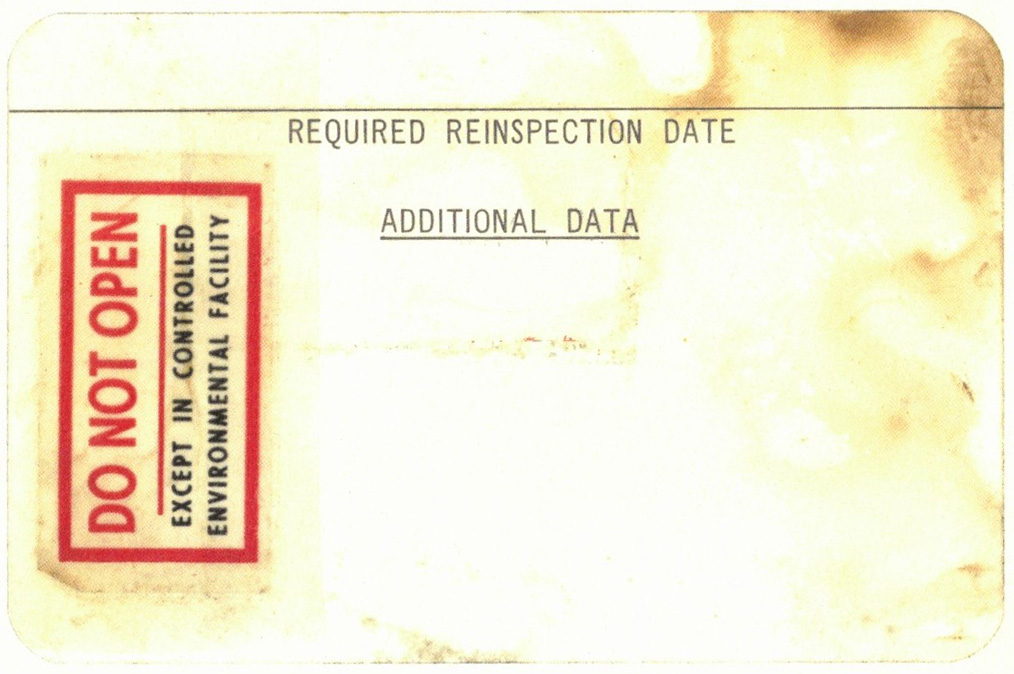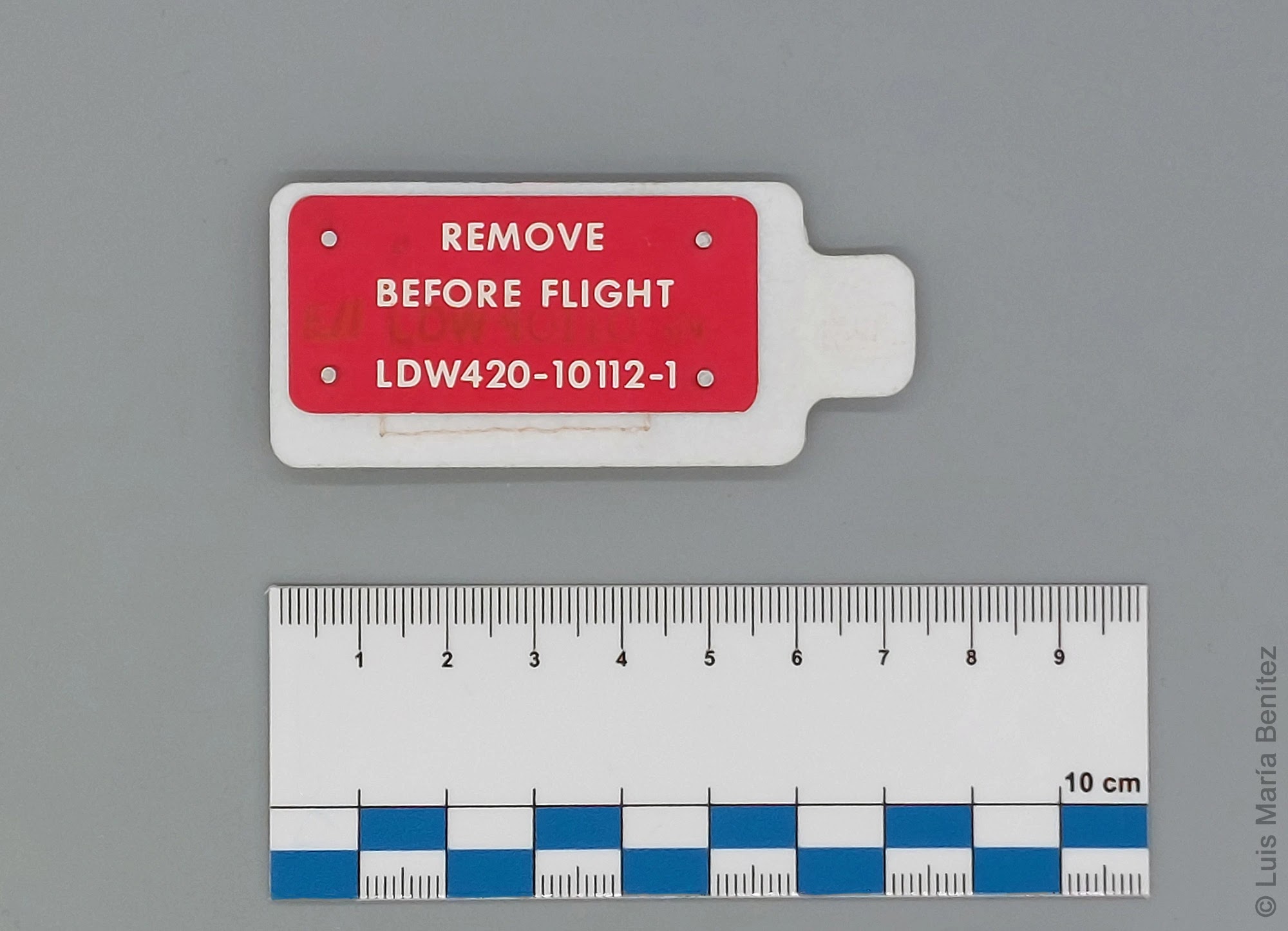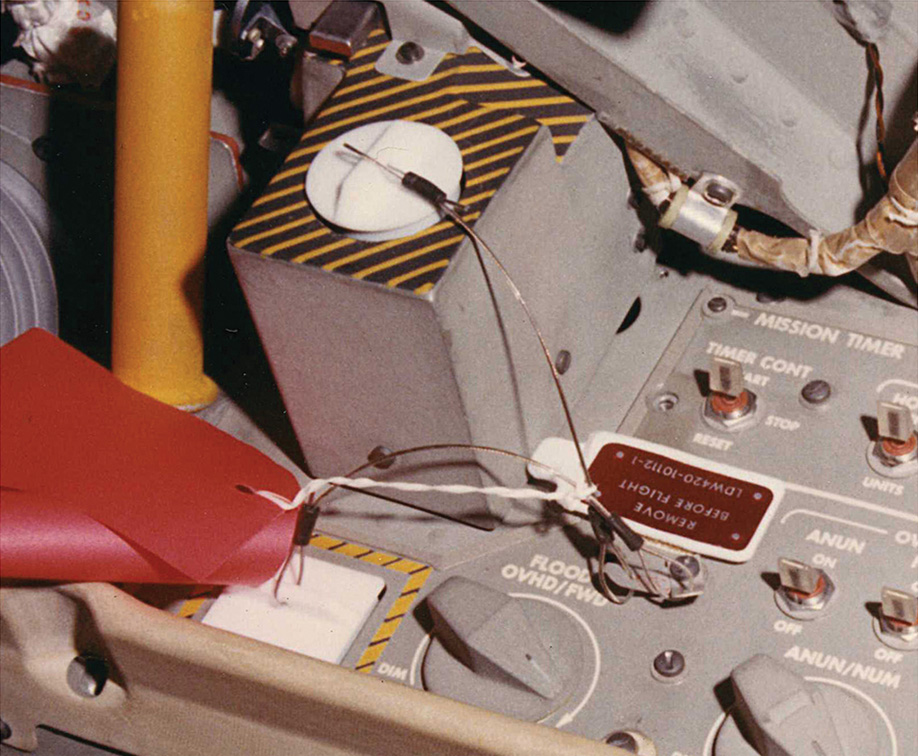June 18, 2024
Artifact: Apollo Remove Before Flight protective cover Artifact Category: protective cover Date of use: between 1969/1972 Manufacturer...
Artifact: Apollo Remove Before Flight protective cover
Artifact Category: protective cover
Date of use: between 1969/1972
Manufacturer: Grumman Aircraft Engineering Corporation
Part Number: LDW 420 P10119-9Serial Number: LDW 420 10110-1 S/N4
NASA Contract Number: NAS9-1100
Spacecraft/Launch Systems: Lunar Module
Materials: Perspex, Velcro.
Dimensions: 5.1 x 2.5 cm
Weight: 5 gr.
Program: Apollo
Flown Status: unflown
Description: Apollo Lunar Module "Remove Before Flight" Protective Cover, Kennedy Space Center, Ground Support Equipment. This artifact was designed to protect critical Flight Hardware in the Apollo Lunar Module Astronaut Fight Deck. It would have been removed just prior to launch at the Kennedy Space Center in Florida. NASA's prime Lunar Module spacecraft contractor, Grumman Aircraft Engineering Corporation, constructed this "Remove Before Flight" tag from clear Perspex material. A patch was affixed to the tag where it would have been attached to an Apollo Lunar Module Spacecraft (possibly Apollo 11 and others). Many of these tags were reused for several LM spacecraft. Cleanliness Level: "C".
This artifact was originally purchased at the Charles H. Bell estate auction in the year 2000 at his Titusville, Florida facility. A copy of the original NASA Manufacturer tag is included.
.jpg)
.jpg)
May 29, 2024
Artifact: Apollo Lunar Module Remove before flight switch cover Date of use: between 1969 to 1972 Manufacturer: Grumman Aircraft Engine...
Artifact: Apollo Lunar Module Remove before flight switch cover
Date of use: between 1969 to 1972
Manufacturer: Grumman Aircraft Engineering CorporationPart number: LDW 420 M80029-1 / LDW 420-80026-1
NASA Contract Number: NAS9-1100
Markings: 1459 on the plastic plug, and 1610 on metal clip
Dimensions: 5 x 4.2 cm (plastic plug), aproximatly 60 cm (wire), 3 x 0.9 cm (metal clip).
Weight: 20 grs.
Program: Apollo.
Flown Status: unflown.
Description: this is a plastic switch cover for the Apollo Lunar Module. Comes from Charlie Bell's collection of space artifacts.
This cover consists of two pieces of thick, patterned plastic held together with a retaining clip and a metal cable from which a Grumman / KSC quality control tag would hang. The only thing that remains from the quality control tag are a couple of eyelets attached to a thin metal wire.
Protective cover as installed in the Apollo 12 LM prior to flight. The photo shows the Panel 5 area below the Commander's window.Credit: Grumman.
Another view of the same area of Apollo 12 Lunar Module, before flight, this time with no protective covers. Source: Apollo Lunar Surface Journal.
I have another remove before flight cover, which according to documentation, was removed from the Apollo 15 LM.
See here.
April 11, 2023
Artifact: NASA/Grumman Apollo Lunar Module transgraphic brochure. Publisher: Grumman. Dimensions: 20.5 x 25.5 cm. Description: Origi...
Artifact: NASA/Grumman Apollo Lunar Module transgraphic brochure.
Publisher: Grumman.
Dimensions: 20.5 x 25.5 cm.
Description: Original NASA/Grumman Apollo Lunar Module Transgraphic brochure printed in the mid-1960s in Germany. This brochure measures 8 x 10 and features eight clear acetate pages with detailed color illustrations of the Lunar Module (LM), showing 118 numbered components which are identified by a legend on the trailing end paper. This is numbered 8514/20M.
More information:
December 31, 2022
Item: Apollo 16 Kapton tape from the Lunar Module Orion. Size: 21 x 29.2 cm (presentation). 1.5 x 1.9 cm & 1.5 x 2.3 cm. (fragments)....
Item: Apollo 16 Kapton tape from the Lunar Module Orion.
Size: 21 x 29.2 cm (presentation). 1.5 x 1.9 cm & 1.5 x 2.3 cm. (fragments).
Description: attached to this certificate are two pieces of light weight pressure sensitive Kaptopn polymide thermal insulation trimmed from the Apollo 16 Lunar Module "Orion" during construction by a Grumman worker. They were part of the thermal protection system of "Orion" and intended to protect it from the extreme heat and cold of outer space. Apollo 16 was the tenth manned Apollo mission and the fifth to land on the Moon. It was crewed by John Young, Charlie Duke and Ken Mattingly. Launched on April 16 1972, the mission lasted 11 days, 1 hour and 51 minutes and concluded on April 27, 1972.
March 26, 2022
Size: 4.8 x 5.8 cm. Manufacturer: Grumman. Program: Apollo. Status: Unflown. Description: In the final stage of Grumman manufacturing/flig...
Size: 4.8 x 5.8 cm.Manufacturer: Grumman.
Program: Apollo.
Status: Unflown.
Description: In the final stage of Grumman manufacturing/flight preparation, some sections of this Gold Mylar Shield/blanket were trimmed off. This piece was likely installed as part of a larger blanket to a LM that flew to the Lunar surface. This item comes from well known collector Jerome Prater in Florida.

After the LM is removed from the spacecraft Lunar Module adapter (SLA), it is exposed to micrometeoroids and solar radiation. To protect the LM astronauts and equipment from temperature extremes, active and passive thermal control is used. Active thermal control is provided by the ECS. Passive thermal control isolates the vehicle interior structure and equipment from its external environment to sustain acceptable temperature limits throughout the lunar mission. The entire ascent stage structure is enclosed within a thermal blanket and a micrometeoroid shield. Glass fiber standoffs, of low thermal conductivity, hold the blanket away from the structural skin. Aluminum frames around the propellant tanks prevent contact between tanks and blanket. The thermal blanket consists of multiple-layered (at least 25 layers) of aluminized sheet (mylar or H-film). Each layer is only 0.00015 inch thick and is coated on one side with a microinch thickness of aluminum. To make an even more effective insulation, the polymide sheets are hand crinkled before blanket fabrication.
This crinkling provides a path for venting, and minimizes contact conductance between the layers. Structures with a high thermal conductivity, such as antenna supports and landing gear members, that pass through the thermal blanket also have thermal protection. Individual blanket layers are overlapped and sealed with a continuous strip of H-film tape. To join the multilayered sections, the blanket edges are secured with grommet type fasteners, then the seam is folded and sealed with a continuous strip of tape. Mylar sheets are used predominantly in those areas where temperatures do not exceed 300° F. In areas where higher temperatures are sustained, additional layers of H-film are added to the mylar sheets.
H-film can withstand temperatures up to 1000° F, but, because it is a heavier material, it is used only where absolutely necessary. Certain areas of the ascent stage are subjected to temperatures as high as 1800° F due to CSM and LM RCS plume impingement. These areas are thermally controlled by a sandwich material of thin nickel foil (0.0005 inch) interleaved with lnconel wire mesh and lnconel sheet. Finally, the highly reflective surfaces of the shades provided for the front and docking windows reduce heat absorption.
More information:
December 03, 2021
Artifact: Lunar Module protective cover tag Manufacturer: Grumman Aircraft Engineering Corporation Dimensions: 7.9 x 3.3 cm. Part number: ...
Artifact: Lunar Module protective cover tagManufacturer: Grumman Aircraft Engineering Corporation
Dimensions: 7.9 x 3.3 cm.
Part number: LDW420-10112-1
Markings / Seals: E// LDW-10110 SN.
Description: used to protect Velcro patches in the cockpit of the Apollo Lunar Module (LM). According to documentation this cover tag was removed from the LM of Apollo 15.
One of the protective tags visible inside the Apollo 12 Lunar Module.
Credit: NASA.
December 03, 2021
Item: Apollo Lunar Module circuit breaker switch Size: 6x2,3x1,2 cm. Description: Switch breaker designed by Mechanical Products Inc., tha...
Item: Apollo Lunar Module circuit breaker switch
Size: 6x2,3x1,2 cm.
Description: Switch breaker designed by Mechanical Products Inc., that was in charge of creating the circuite breakers for the Lunar Module. It comes from the Charles Bell Estate.
December 02, 2021
Item: Franklin Mint Precision Space Models - Apollo 11 Lunar Module Size: 23.8 x 23.8 x 16.5 cm. Weight: 1,428 gr. Manufacturer: Fran...
Item: Franklin Mint Precision Space Models - Apollo 11 Lunar Module
Size: 23.8 x 23.8 x 16.5 cm.
Weight: 1,428 gr.
Manufacturer: Franklin Mint.
Description: the model in my collection needs a restoration work. I'm working on it and once everything is fixed I will update the picture here.

.jpg)
.jpg)
%202.jpg)
.jpg)
.jpg)
.jpg)
.jpg)
.jpg)
.jpg)















Follow me